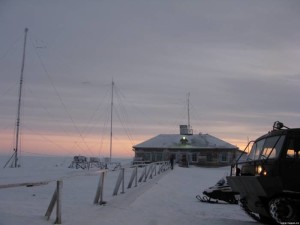Where is the worst location on Earth for solar energy?
As we have discussed in a previous post, one of the main determinants of solar radiation at a given site is its latitude. Generally speaking, the higher the latitude, the lower the solar radiation level will be. This is purely a result of the Earth's shape: the sun's rays are distributed across a larger geographical area as we move further away from the equator. Thus, the amount of solar energy falling on a given area naturally decreases as we move towards the polar regions.

Image credit: ru.wikipedia.org
However, you may be surprised to learn that the poles are actually not the worst places to be when it comes to solar energy. This honor belongs to an archipelago in Russia within the Arctic Circle (located at 78 degrees North and 100 degrees West). This northern island group, called Severnaya Zemlya ("Northern Land" in Russian), consists of five main islands and many smaller ones. All of these islands are uninhabited except for a three-person crew of a Russian meteorological research station located at the Golomyanny island. Why not Discover solar energy where you live?
Higher latitude and overcast conditions: Not a good combination for solar
According to our global solar radiation database, this area has a daily average global horizontal irradiance of 1510 watts/m2 . While it is not a big surprise that the worst location for solar energy on Earth is near one of the poles, this site is more than 1,000 kilometers away from the North Pole itself. The reason for the very limited amount of solar radiation at this location is the double whammy of a very high latitude combined with generally overcast skies due to the local micro-climate.
Running the numbers for Severnaya Zemlya

Golomyanny Weather Station (image credit: ap / tugun.ru)
So how bad is the solar radiation potential on this site? If we were to install an average-sized residential solar photovoltaic system (with a capacity of 5 kW) on this location, we would produce around 2800 kWh of electricity during the year, or about 7 kWh per day. As we highlighted in a previous post, this level is only about a quarter of what the same system would generate at the best solar energy spot on Earth. While this amount of solar energy is clearly not sufficient to meet the needs of an average North American household, even the worst solar site on Earth can yield useful amounts of electricity from late Spring to early Fall. Paired with LED lights and mobile electronic devices (such as cell phones, tablets and laptops) solar energy can meet basic lighting and computing needs in this region for part of the year. Obviously, in order to secure a reliable power source, a diesel generator would also have to complement the solar panels. Even this marginal contribution of solar can be valuable if it decreases the need for shipping diesel fuel to this remote region.
We should also note that the daily average values can be very misleading at extreme latitudes. In winter months, there's hardly any solar radiation available at this site, making solar energy not a feasible option at all during these months. Thus, pairing a diesel generator with another renewable energy system, such as a wind turbine, can also be a viable option. After all, wind turbines can produce electricity during the night as well as during cold and dark winter days.
Not entirely game over for solar
It's hard to make a case for solar in this region based on the numbers above. These numbers are also a good reminder that solar energy is not suitable for every single location on Earth. It's no wonder that nuclear-powered icebreakers and diesel generators are the workhorses of the Russian scientific activities in this region. However, there is still an interesting niche for solar: portable power. When expeditions need power for their portable equipment (such as satellite phones, mobile computing devices and navigation equipment), solar panels can be an essential part of their kit. In fact, we had the pleasure of helping an expedition team to do just that and use solar energy in an extreme environment. More on that very soon!